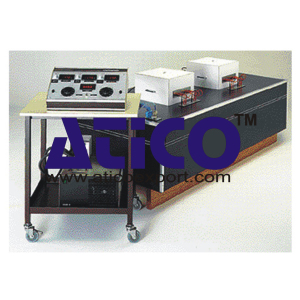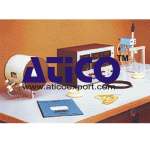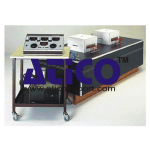Thermal Coefficient Of Materials Measurement Unit
A uni-directional heat flux is created through the test specimen, and measurements are made when the steady state is reached.
The parameters measured are those necessary for defining the heat transfer characteristics of a given material :
- Thermal conductivity,
- Thermal diffusivity,
- Specific heat.
Measurements can be made more rapidly than by other methods, for one or two samples depending on the selected configuration of the test unit (3 options are available).
The units have many applications for teaching, research and industrial testing.
Tests and experiments
The measurement unit can be used to determine the thermal coefficients of homogeneous or heterogeneous materials and liquids, with one or two test boxes depending on the tests to be carried out.
In the case of liquids or granular materials (powders or sand) the samples are placed in an hermetic box, with copper plates on the upper and lower surfaces.
Normal test temperatures are near ambient, but if required, materials can be tested at temperatures up to 80°C. The specimen dimensions are 270 x 270 mm, with thickness varying from 30 to 70 mm.
Typical applications :
a) Laboratory experiments and students projects :
Using a twin-box system and depending on the types of boxes used.
- Simultaneous measurements of thermal conductivity, l, on materials.
- Comparison of steady-state temperature differences for two specimens.
- Studies of temperature responses to transient conditions.
- Measurements of heat transfer coefficient, K, on both faces of a specimen.
- Measurements of thermal diffusivity, a.
b) Research :
- Study of thermal characteristics of homogeneous and heterogeneous materials, as a function of their composition. Verification of theoretical models and empirical relations.
- Study of characteristics as a function of material water content.
- Evaluation of ageing effects on thermal characteristics.
c) Routine testing :
- With a twin-box unit, measurements on up to 6 to 8 specimens per day can be carried out. The unit is suited for repetitive measurements on building and insulating materials, sand, powders, liquids for the food industry, etc.
Technical specifications
The measurement unit comprises :
- A heavily insulated test cell maintained at a low temperature (approx. – 5°C) by means of a cooler through which passes a water-glycol solution, which is cooled by means of a cryostat.
- One or more specimen test boxes, depending on the selected configuration :
for thermal conductivity measurements, the box is fitted with a flat heater element on its upper internal face. The heat flux is controlled by a rheostat. for thermal diffusivity measurements, the test box which has internal reflecting surfaces, is fitted with an incandescent lamp. - A heat flux is emitted for a few seconds by means of the lamp.
- The specific heat is determined from measurements of the thermal conductivity and diffusivity.
- The cables from the temperature probes and the heater element are connected to the measurement console through a terminal box.
Equipment Package :
- Single box test unit for measurements of thermal conductivity or diffusivity with option.
- Complement for measurements of thermal diffusivity.
- Twin box test unit, for simultaneous measurements of thermal conductivities of two specimens or conductivity and diffusivity with option
Each unit is supplied complete with a measurement console.
Dimensions and weight
- 1200 x 1000 x 800 mm, 25 kg
- 2000 x 1000 x 800 mm, 40 kg
Essential requirements
- 220 V, single phase, 50 Hz
- 115 V on request



